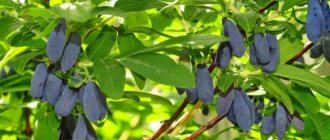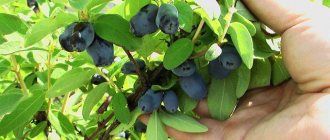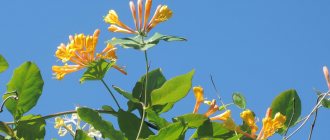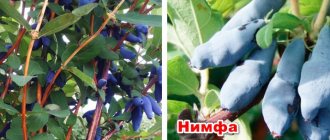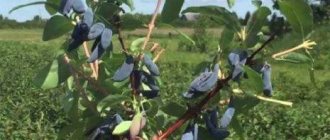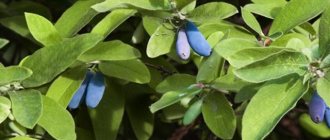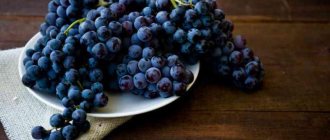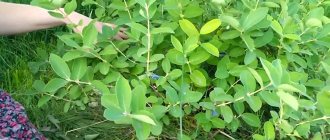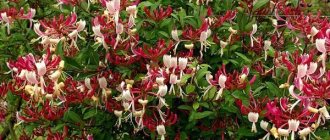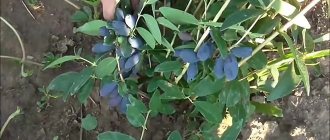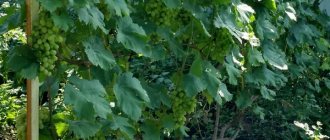HONEYSUCKLE “AURORA”, description of the variety.
Aurora is not just a new product - an achievement and breakthrough in honeysuckle selection! This has never happened before among honeysuckles! Honeysuckle Aurora is the latest variety of Canadian selection, obtained in 2012 at the University of Saskatchewan from the Russian variety “Nightingale” and the Japanese numbered variety. The bush is dense, compact, 1.5-1.8 m high, fast-growing, with strong, flexible shoots. It blooms at the end of May, when almost all honeysuckles have already bloomed. It bears fruit later than traditional varieties: from the end of June almost to the end of July. The berries are large, up to 3cm long, often up to 1cm in diameter, weighing up to 3g or more(!), elongated oval in shape, blue-violet, fleshy, with a very dense skin. The taste is gorgeous, sweet with a pleasant sourness, absolutely no bitterness. Noticeable berry aroma. There is no shedding: the berries hang on the bushes even after the leaves fall! Long-term fruiting not only allows you to extend the time of consumption of the extremely healthy and incredibly tasty berry, but also greatly increases its market potential. Frost resistance of Aurora honeysuckle is -46°C.
Considering the later flowering of “Aurora”, we recommend planting varieties from the same series that bloom at the same time nearby for cross-pollination: “Northern Beauty”, “Northern Monster”, “Northern Buran”, “Honeybi” and “Indigo Jam” are a good choice "
Botanical description
Wild species of honeysuckle (Lonicera) mainly come from northern regions, so most cultivated varieties are winter-hardy. The height of the wild bush reaches 1.8 m, which makes it an excellent candidate for building decorative hedges and decorating the walls of outbuildings. The bush consists of 10–15 erect shoots. Among all types of honeysuckle you can find deciduous and evergreen varieties. Flowering begins very early.
The berries begin to change color from green to blue 10 days after they are formed. You can determine maturity by how the color becomes more saturated. Ripe berries taste sweet, slightly bitter and tart.
The flesh of edible varieties takes on a red tint inside. But do not confuse them with ornamental varieties that have red skin.
HONEYSUCKLE "AURORA" buy seedlings.
We guarantee the quality of honeysuckle seedlings and are responsible for their safety in transit. Thanks to professional packaging and a closed root system, honeysuckle seedlings arrive in excellent condition to any region of the country.
Order seedlings: in the online store, by phone 4, by email. mail
The average cost of shipping by Russian Post is 300-350 rubles, shipping by EMS airmail is on average 1500-1800 rubles.
Answers to frequently asked questions:
2. We do not trim shrub seedlings to the size of the box and do not remove strawberry leaves (the plants tolerate shipping with leaves well!; sometimes, during a particularly long shipment, the leaves may become slightly discolored - this is quite normal!)
3. If possible, we try to take into account your wishes about delivery times, so that you have the opportunity to choose a suitable time for landing (the weather has been favorable in the region, a place has been prepared for landing, etc.)
4 . We do not purchase plants or hire hired workers: we grow, assemble and pack the plants ourselves - very meticulously, thoroughly and scrupulously - we work for quality, not speed! Sometimes this means you may have to wait a bit for your order - be patient!
5. Thanks to professional packaging, strawberries in parcels never get wrinkled, and bushes never break!
6 . All plants were grown in the Urals (northern Perm region) in open ground in a risky farming zone and adapted to difficult climatic conditions. For example:
— end of October 2021: no snow, temperature -16-18 degrees C; — January 2021: during the week it costs -45 UAH; — June 1, 2021: it’s snowing, etc.
The Ural weather constantly presents us with such surprises, but the species and varieties of plants we have selected live, grow, bloom luxuriantly and bear fruit magnificently no matter what!
7. Working with LIVE plants in considerable volumes, sending them to the most remote regions of the country and even abroad, we extremely rarely receive quality complaints (there were only 4 of them in 2021!), so if for some reason the plants damaged during shipment, we can afford to resend the plants to the customer free of charge!
8 . Within 1-2 days after sending the parcel, we will inform you of the track number to track it (message to phone and email). In addition, we ourselves track your shipment and notify you of its arrival at the specified post office. You don't have to worry about where the package is.
9. In the off-season, you can consult with manufacturers. We will tell you how to choose the right crops and varieties, prepare the soil, plant plants, feed, shape, propagate, spending a minimum of effort, getting maximum returns. We have a wealth of experience and we are ready to share it! Contact us! NOTE! In the spring-summer period, during the work and mailing season, due to workload, we are not able to provide advice or answer all calls and messages! Hope for understanding!
10. Family works! Manual labor without outside help requires considerable time and physical effort, eliminates re-grading and confusion, and guarantees high quality planting material. This is where the price of our products comes from.
11. Our collection of plants, collected since 1988, contains new items from domestic and foreign selection, unique rarities and selected varieties of favorite classics. Do you want to get consistently high yields of berries on your plot and decorate your garden with stunningly beautiful ornamental plants? We invite you to cooperate! The choice is huge - choose!
Sincerely, Agro (Perm).
Planting and care
For honeysuckle, choose an area with good lighting. It is recommended to place the plants in a permanent place; replanting is allowed only for young bushes. The soil should be well-drained, loamy with neutral acidity. Excessively acidic or carbonate soils are not recommended, because the yield will be low.
Honeysuckle is planted using seedlings that are purchased in specialized stores. In addition to specimens of the Aurora variety, bushes of other species are purchased. Plants that are 2 years old and have 2-4 dense, undamaged shoots take root well.
The branches should be flexible, reach 60 cm in length, with formed buds. The root system of the seedling is fibrous, includes thick roots and small branches. Before planting, young bushes must be acclimatized; the pots are taken out into the open air for 2-3 hours throughout the week.
Planting honeysuckle is allowed at different times of the year, except in winter. For seedlings with an open root system, planting is recommended in early spring, in the second half of summer or autumn. A period of adaptation of the plant to the new site is necessary, so planting work is carried out no later than 1 month before the cold snap.
The area is dug up, lumps are separated, grass and stones are removed. From above, the area is covered with a nutritious soil layer with the addition of superphosphate (3 tbsp) and wood ash (1 l).
The holes are dug at intervals of about 1-1.5 m. The holes for honeysuckle seedlings should be up to 60 cm wide and up to 50 cm deep. Compost or rotted manure (2 buckets) must be added to each hole. If the area is swampy, it is recommended to fill the bottom of the hole with drainage made of expanded clay granules or gravel.
We recommend that you read: Preparing raspberries for winter in Transbaikalia
Planting is carried out on a sunny day at an air temperature of at least +15°C. The soil should be heated to +10°C and with a humidity level of at least 80%. A trellis or trellis is installed near the holes before placing the seedling.
Before planting, the plants are removed from the container with a ball of earth and placed vertically in a pre-moistened hole. Then the hole is filled with soil. The soil must be compacted to prevent the formation of voids. The root collar of the seedling should remain at ground level. After sprinkling with soil, the plant needs watering. Then the soil is mulched with humus to prevent moisture evaporation.
Caring for honeysuckle includes regular watering, fertilizing, pruning, treating insect pests, etc. Irrigation of bushes should be carried out regularly. The plant's greatest need for moisture is during the period of fruit filling and ripening. At least 10 liters of settled water is poured under the bush. During dry periods, the volume of liquid increases, but excess moisture should not be allowed.
Honeysuckle cannot withstand stagnation of water in the root system. Experts recommend taking into account weather conditions and the condition of the plants when watering.
A bush up to 3 years old does not need to be fertilized, because... The nutrients added during planting are sufficient for the development of the seedling. After 3 years of growth, honeysuckle begins to be fed with organic compounds in the summer. It is optimal to add compost, manure, and humus under the bush. With small crop growth, it is necessary to fertilize with nitrogen fertilizers in the spring.
For a spring procedure, you can prepare an organic composition. To do this you will need the following herbs:
- clover;
- sagebrush;
- mustard;
- weeds.
The plants are crushed, filled with settled water and infused for several days. Before applying it under the bushes, you can add dolomite flour to the fertilizer at a ratio of 150 g per 5 liters of water.
Before flowering, honeysuckle is fertilized with liquid manure or chicken droppings. You will need to add 1 kg of the composition to water (5 l) and mix. The solution nourishes the roots of the plant, strengthens the immunity of the fruit crop, and increases productivity. However, it is not recommended to exceed the dosage of fertilizers.
We recommend checking out Barberry Pink Queen
Organic fertilizer can be made from lawn grass and straw, dolomite flour. The plants are crushed, mixed with flour, filled with water (5 l) and infused for several days.
Pruning for fruit crops is carried out annually in spring and autumn. It is necessary to inspect the bush, remove dried and broken branches, and also cut off old stems. Abundant fruiting of honeysuckle occurs in the 7th year of growth. Therefore, when trimming, it is recommended to maintain the culture and cut off old shoots. It is optimal to leave up to 15-20 skeletal branches of different ages on the bush. In autumn, shrubs are cleared of broken stems and dry leaves.
The Aurora variety is frost-resistant and can withstand air temperatures down to -40 °C. The procedure for preparing for winter includes covering the root areas of the bush with humus, this will prevent the root system from freezing.
Honeysuckle 2021
Moderators: Vital, Roman S.
- Go to page:
Moderator Messages: 3734 Registered: 10.20.2013, 23:24 From: Ryazan Thanked: 4553 times Thanked: 6280 times
Status: Online
Honeysuckle 2019
Message from Roman S. » 12/19/2018, 11:48
Discussion of other seasons:
Messages: 520 Registered: 11/30/2015, 2:02 pm Thanked: 410 times Thanked: 377 times
Reproduction
Kamchatka honeysuckle can be propagated by seed or vegetative methods. In the first case, the parental characteristics are not preserved, so it is not a fact that the same fruitful and sweet variety will grow from the seedling. For practical gardening, methods of vegetative propagation such as cuttings or dividing a bush are more applicable.
Green cuttings of Kamchatka honeysuckle take root well
Cuttings are a simple and affordable way to propagate the desired honeysuckle variety. You can root cuttings several times during the season:
- Late March or early April. Cuttings 15-17 cm long are cut from branches at least 7-8 mm thick. The lower cut is treated with a root formation stimulator and planted obliquely in the ground to a depth of about 10 cm so that 2 or more buds remain on top.
- After flowering. At this time, annual shoots with fresh growth can be used as cuttings. Cut branches are planted to a depth of 5-7 cm.
- End of June. At this time, green cuttings are used - the current year's growth. They are cut off with the apical bud and planted to a depth of about 10 cm. It is very important that the soil at the planting site is constantly moist.
Another way of vegetative propagation of honeysuckle is by dividing the bush. This operation can only be performed on honeysuckle over 8 years old. A bush dug out of the ground is cut into several parts so that each section contains at least 3 shoots and a part of the rhizome at least 0.4 m long.
Dividing a bush is a quick and effective way to propagate your favorite honeysuckle variety.
The seedlings obtained in this way should be immediately planted in a new location.
Range
- seedling cassettes of the " multiplate
" type made of foam plastic (modular pallets)
M-90
- multiplate size: 31 cm x 53 cm x 4.5 cm,
90 pieces of one variety
per cassette - seedling height 4-8 cm - many varieties are already branched ( blueberry branched from the base);
— licensed and protected varieties in p9 flower pots are available from the company:
PLANTIN SPÓŁKA Z OGRANICZONĄ ODPOWIEDZIALNOŚCIĄ SPÓŁKA KOMANDYTOWA ul. Zbyszka z Bogdańca 16 31-979 Kraków
Nursery location: Muniakowice 100 32-090 Słomniki GPS: 50°17'31″N, 20°06'59″E Sales department tel.: +48 12 643-15-20 e-mail
Secretariat tel.: +48 12 388-92-77 e-mail We inform you that from 03/21/2016 the sales department will be transferred to the village of Munjakovice approx. The town of Słomniki in the Krakow district of Lesser Poland Voivodeship. Acceptance of goods is also carried out exclusively at the address: p. Muniakovice no. 100, 32-090 Slomniki. We cordially invite you to visit us at our new location!
— the rest of the range is offered in p9 flower pots:
Gospodarstwo Ogrodnicze Waganowice Paulina Kusibab-Popowicz i Mirosław Popowicz Spółka Cywilna Waganowice 44a 32-090 Słomniki tel.: +48 12 442-60-50; +48 607-178-304; GPS: 50 o 14'15” N, 20 o 08'43” E e-mail www.gowsc.pl
as well as Gospodarstwo Ogrodnicze Aleksandra Kusibab-Wyka i Marcin Wyka Prandocin Iły 88a 32-090 Słomniki tel./fax: +48 12 385-79-44 tel.: +48 509-937-482 GPS: 50 o 17'40” N , 20 o 05'07” E-mail www.goakw.pl
Advantages and disadvantages
Main advantages:
- early ripening;
- large berries;
- good resistance to drought and cold;
- low maintenance requirements;
- formation of a neat bush;
- a good option for creating a berry garden or alley.
Flaws:
- weak immunity;
- requires more space for normal development of the bush.
Difference from other varieties and hybrids
The bush is pollinated by night moths. Other differences: elongated leaves, no pubescence on the top of the berries.
Honeysuckle Aurora
Honeysuckle "Aurora" - One of our new products. The variety originates from the Russian variety “Nightingale” and the Japanese variety “MT 46.55”. Quite a fast-growing variety. Ripening already at the end of May, “Aurora” bears fruit one of the first in the season.
Winter-hardy shrubs of this honeysuckle are well resistant to diseases and many pests.
The sweet-tasting Aurora fruits contain a large amount of vitamins that are very beneficial for health.
The berries are blue-blue, with a strong waxy coating, and are absolutely devoid of bitterness.
The yield of this honeysuckle variety is approximately 5-6 kg per bush. The important thing for large berries is that they do not fall off for quite a long time. Delicate soft fruits have a light aroma. Tasting score for ripe, harvested fruits: 5.0.
Unpretentious honeysuckle reaches a height of 120 cm and a width of 70-80 cm. To ensure cross-pollination, we recommend using varieties such as “Indigo Jam”, “Borealis”, etc.
History of selection
Honeysuckle is the first garden crop to ripen in garden plots. And this quality is reflected in the name of a particular variety - Aurora. He will delight you with berries already in mid-June.
Aurora was obtained by crossing Solovey varieties and some varietal forms from the Maxine company as part of the Thompson breeding program at the University of Saskatchewan (Saskatoon, Canada). Selection work began in 2007, variety testing was completed in 2016. Therefore, we can say that Aurora is one of the newest edible varieties of honeysuckle.
During variety testing, this sample received the highest rating for the taste of the berries, their size and yield. Canadian variety trials consist of planting 5 copies of each sample on a plot of 3 m² with a distance of 0.6 m between them. Only those samples that showed no more than 5% deviations from the declared indicators are allowed for further cultivation.
Important! Edible varieties of honeysuckle
—
owners of blue berries. Decorative varieties have red berries and are very poisonous. Black-fruited varieties may be non-poisonous, but they are still generally inedible.
detailed information
Origin of the variety
Aurora honeysuckle is a Canadian variety.
Features of growth
Dense, compact, erect bush. Ripening period is mid-early.
Diseases/Pests
Winter-hardy shrubs of this honeysuckle are perfectly resistant to diseases and most pests.
The flowers are yellow.
The fruits are large, bluish-blue, with a waxy coating. The sweet-tasting Aurora fruits contain a large amount of vitamins that are very beneficial for health.
Pollinators
The plant has bisexual flowers and is self-pollinating. But gardeners note that if 2-3 different varieties of honeysuckle grow nearby, this significantly increases the yield of each of them. Suitable varieties as companions are Tundra, Honey Bee, Borealis - of Canadian origin, or Russian Blue Velvet, Tomichka.
Useful properties of honeysuckle for women
The benefits of honeysuckle for the health and beauty of the fair sex:
- The antiseptic properties of the berry pulp are used in the fight against skin problems - they help get rid of acne, rashes, blackheads, relieve redness, tighten pores, without drying the skin.
- Based on ripe fruits, natural face masks rich in natural strength are made. They tone, soothe, moisturize and vitaminize the skin.
- Edible honeysuckle flower extract is included in anti-wrinkle creams.
- To preserve youthful skin, cosmetologists and beauty experts recommend washing your face with a decoction of honeysuckle flowers.
Harvesting and storage
Ripe honeysuckle berries appear in early June. The appearance of a blue color on the fruits does not mean that the berries are completely ripe and ready for picking. After the berries acquire a bright color, you need to wait another week.
Like honeysuckle, it is recommended to use raspberries, lingonberries, and black cumin oil for colds.
The fruits ripen in stages: first on the tops, in the depths of the bush, and only then the lower berries ripen.
You need to be prepared for the fact that honeysuckle fruits are liked by birds that peck out ripe berries. When the berries begin to ripen, it is worth spreading a black film under the bushes, which will not allow the fallen berries to get dirty.
It is convenient to collect varieties with crumbling berries by shaking them, placing a cloth or film under the bush. Then the harvest will consist only of sweet and ripe fruits. It is better to place the collected berries in a thin layer or in a small container.
The transportability of the variety is very good. The crop is suitable for both mechanical and manual harvesting.
Did you know? The bush takes care of its productivity. That is why, immediately after the fruits ripen, the bush discards them, preserving the strength for the ripening of green berries.
Berries are stored for a short time even in a cold place, so if possible, it is better to freeze the harvest in the freezer. Frozen fruits are used as fillings, decorations for desserts, for preparing vitamin smoothies, etc.
When defrosted, the berries retain their taste and beneficial properties.
Honeysuckle of Canadian selection - a breakthrough in the horticultural market
Edible honeysuckle is a unique berry crop. In winter it can withstand frosts up to 50 degrees. Its flowers can withstand spring frosts down to minus 5, and short-term frosts up to minus 8 degrees.
Honeysuckle is the earliest berry in our gardens, and it is also very early-bearing - it begins to bear fruit the next year after planting. Honeysuckle is a very durable shrub that retains high productivity until the age of 25-30 or more years. Weakly damaged by diseases and pests.
